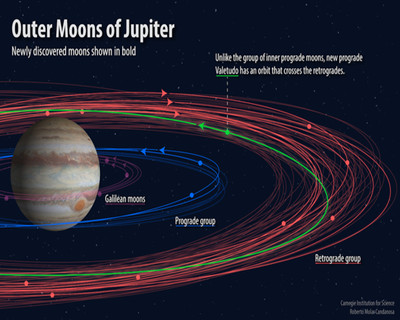(单词翻译:单击)
听力文本
This is Scientific American — 60-Second Science. I'm Steve Mirsky.
How many moons does Jupiter have? If you said four, you might be Galileo. If you said 69, you were right. Until the announcement this morning by the International Astronomical Union of the discovery of an additional 10 moons about the gas-giant planet. Bringing the currently known total to 79. That's a lot of moons.
A research team from the Carnegie Institution for Science, the University of Hawaii and Northern Arizona University was looking in 2017 for very distant objects in our solar system, well beyond Pluto. Jupiter happened to be in the same field of view, so they also looked for any as yet unknown moons. They found 12, two of which were announced last year. Confirmation of the moons required multiple observations, and those data enabled a calculation of the moons' orbits.

Nine of the dozen moons are well away from Jupiter and have retrograde orbits, meaning they go around the planet in what we'd think of as the "wrong direction". They take about two Earth years to complete their circuits.
Two new moons are closer in, go the right way, and take about an Earth year for one orbit. Those eleven moons are probably remnants of larger bodies that got broken up in collisions.
The remaining moon is less than a kilometer across, further out than the two conventional moons and has a 1.5-year orbit—and the orbit is inclined. That tilt has the weird little moon crossing the paths of those outer retrograde moons. Which means an increased likelihood of a big smash-up one day.
Depending on what survives from any such collision, Jupiter may then have even more moons. Or a couple fewer.
Thanks for listening for Scientific American — 60-Second Science. I'm Steve Mirsky.
参考译文
这里是科学美国人——60秒科学。我是史蒂夫·米尔斯基。
木星周围有多少颗卫星?如果你说有4颗,那你可能是伽利略。如果你说有69颗,那你曾经是对的。因为今天早上,国际天学文联合国宣布,他们发现木星这颗气态巨行星的卫星又增加了10颗。这使目前已知的木星卫星总数达到79颗。木星真的有很多卫星。
2017年,来自卡内基科学研究所、夏威夷大学和北亚利桑那大学的一个研究小组,在太阳系中寻找比冥王星的距离还要远得多的遥远天体。木星恰巧也在同一个研究视野中,因此,他们也寻找了以前未知的卫星。他们发现了12颗卫星,其中两颗在去年公布。确认卫星的发现需要多次观测,这些数据可以估算出木星的运行轨道。
这12颗卫星中有9颗离木星非常远,处于逆行轨道上,这意味着它们以我们认为“错误的方向”绕木星公转。这些卫星绕木星公转一圈需要大约2个地球年的时间。
两颗新卫星离木星的距离更近,而且轨道方向与木星一致,绕木星公转一圈需要1个地球年的时间。上述11颗卫星可能是体型更大的天体碰撞分裂后产生的残余物。
最后1颗卫星直径不到1公里,比上述2两颗顺行卫星距离木星更远,绕木星一圈大约需要一年半,而且其轨道是倾斜的。这种倾斜让这颗古怪小卫星的轨道穿越那些外围逆行卫星的轨道。这意味着它与其他卫星未来发生大碰撞的几率大大增加。
从这种碰撞留下的幸存卫星来看,木星当时的卫星数量可能比现在更多。也可能少几颗。
谢谢大家收听科学美国人——60秒科学。我是史蒂夫·米尔斯基。
译文为可可英语翻译,未经授权请勿转载!
重点讲解
重点讲解:
1. happen to do sth. 碰巧;凑巧;
She happened to be out when we called.
我们打电话时她刚巧不在家。
2. look for 找;寻;
We all need to look for ways to reduce our carbon footprint.
我们都需要寻求降低碳排放量的方法。
3. be away from 离(某人或某地)有一定距离;
The company is so far away from my dorm that I had to spend much time on the way.
公司离我的宿舍太远,我不得不花很多时间在路上。
4. break up (使)分裂;(被)拆分;(使)破碎;
There was a danger of the ship breaking up completely.
这艘船有彻底解体的危险。


